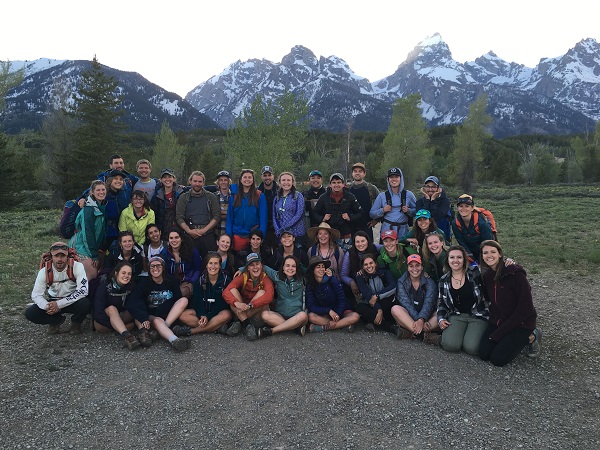
With the arrival of summer comes wildflowers, long days, and hours of outdoor recreation. Best of all, summer brings a large addition of talented folks to the Field Education team. This summer we happily welcomed back 12 instructors. All were previously members of this past year’s AmeriCorps cohorts. These 12 folks made us wonder: what pulls people back to Teton Science Schools after time away? We were able to connect with a member of each cohort from the past year.
 Scott Whisler (AmeriCorps Cohort Fall 2016)
Scott Whisler (AmeriCorps Cohort Fall 2016)
Coming to TSS in the fall, I was excited to experience a new place and group of people that I knew would challenge and support me. I did not expect this community to grow into something that I admire as much as I do. One moment does not stick out in my mind as the inspiration I needed to return. Rather, it was a collective of moments that built this place to be all it is to me. The TSS community is special. From interactions within the work day to those during our independent time, I found myself forming bonds with people that challenged me to be the best educator and person I could be.
In returning this summer, I am excited to take on new roles and responsibilities that will continue to develop me into a better educator. My excitement only increases when I think about the amazing opportunity I have to mentor the summer cohort of AmeriCorps. At this moment, AmeriCorps members are heading out on their first week in the field. I am excited to hear of the many successes I am sure they will have; I am also excited to support them in their frustrations.
Looking back on my AmeriCorps season, I realize the peaks and valleys were all significant because of the instructors and faculty who were by my side through it all.
 Sarah Davis (AmeriCorps Cohort Winter/Spring 2017)
Sarah Davis (AmeriCorps Cohort Winter/Spring 2017)
When I think back on programs, I think of individual students. Their excitement, incredible insights, and character growth as little humans is what convinced me to continue as an instructor this summer. Helping facilitate these connections to place, if only for a week, is enough.
I truly enjoying connecting students to this beautiful place we get to call home. I find connections are best made through immersive experience. Allowing students to decide what that means to them is a powerful experience.
Becoming an instructor has naturally given me more responsibilities, but it has also allowed me the freedom to explore my own teaching style and techniques. This summer means more exploration, both for the students and for me! Yay to summer!”
 Colin Rye (AmeriCorps Cohort Summer 2016)
Colin Rye (AmeriCorps Cohort Summer 2016)
There is one program in particular that I worked last summer which stands out to me to this day. Children’s Grand Adventure (CGA), a program made up of teenagers in remission from cancer from the Texas Children’s Hospital in Houston, might be the reason I decided to return to TSS for a second season. First, I enjoy working with students from other places who often have not been anywhere like here before. There is something particularly refreshing about experiencing this place through a dozen or so pairs of fresh eyes. Taking the group up the tram to the top of Rendezvous Mountain to play in the lingering July snow was awesome. Second, it was amazing to work with young people who have persevered through such serious health issues without losing their childlike sense of fun or overall positive attitudes. Several students were still experiencing lasting health issues; their tenacity and outlook in spite of these setbacks were inspiring.
I enjoy leading discussions with students about big picture issues at the interface between humans and the natural world, such as global climate change and water conservation. Two moments from last summer immediately come to mind. One was a casual conversation with a student during CGA while riding back from a field day. This young man, middle-school aged, had never been taught about human-caused global climate change and its impact on the natural environment. I could see the wheels turning behind his furrowed brow as he asked about what would happen to the glaciers in the Tetons and what he could do to help ameliorate increasing impacts. Another time, I decided to lead a lesson centered on water use issues and water conservation, one of the first times I created a lesson from scratch as an AmeriCorps intern. The group was a day program for third and fourth graders, and I still vividly remember sitting in the shade of conifers by Ditch Creek, jotting down on a small whiteboard the children’s ideas on how we could help conserve water. The ideas generated in both of these cases are quintessential examples of why I choose to work with young people, and more specifically, why I choose to work as an outdoor environmental educator with Teton Science Schools.


